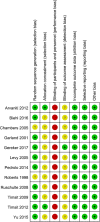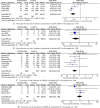Chlorhexidine-impregnated dressing for the prophylaxis of central venous catheter-related complications: a systematic review and meta-analysis
- PMID: 31096918
- PMCID: PMC6524337
- DOI: 10.1186/s12879-019-4029-9
Chlorhexidine-impregnated dressing for the prophylaxis of central venous catheter-related complications: a systematic review and meta-analysis
Abstract
Background: Several randomized controlled trials (RCTs) evaluated the role of Chlorhexidine-impregnated dressing for prophylaxis of central venous catheter (CVC) related complications, but the results remained inconsistent, updated meta-analyses on this issue are warranted.
Methods: A meta-analysis on the RCTs comparing Chlorhexidine-impregnated dressing versus other dressing or no dressing for prophylaxis of central venous catheter-related complications was performed. A comprehensive search of major databases was undertaken up to 30 Dec 2018 to identify related studies. Pooled odd ratio (OR) and mean differences (MDs) with 95% confidence intervals (CI) were calculated using either a fixed-effects or random-effects model. Subgroup analysis was performed to identify the source of heterogeneity, and funnel plot and Egger test was used to identify the publication bias.
Results: A total of 12 RCTs with 6028 patients were included. The Chlorhexidine-impregnated dressings provided significant benefits in reducing the risk of catheter colonization (OR = 0.46, 95% CI: 0.36 to 0.58), decreasing the incidence of catheter-related bloodstream infection (CRBSI) (OR = 0.60, 95% CI: 0.42 to 0.85). Subgroup analysis indicated that the Chlorhexidine-impregnated dressings were conducive to reduce the risk of catheter colonization and CRBSI within the included RCTs with sample size more than 200, but the differences weren't observed for those with sample less than 200. No publication bias was observed in the Egger test for the risk of CRBSI.
Conclusions: Chlorhexidine-impregnated dressing is beneficial to prevent CVC-related complications. Future studies are warranted to assess the role and cost-effectiveness of Chlorhexidine-impregnated dressings.
Keywords: CRBSI; Central venous catheter; Chlorhexidine; Nosocomial infection; Nursing care.
Conflict of interest statement
The authors declare that they have no competing interests.
Figures
Similar articles
-
Improving central venous catheter care with chlorhexidine gluconate dressings: evidence from a systematic review and Meta-analysis.J Health Popul Nutr. 2024 Nov 1;43(1):177. doi: 10.1186/s41043-024-00672-7. J Health Popul Nutr. 2024. PMID: 39487464 Free PMC article.
-
Chlorhexidine-impregnated sponge versus chlorhexidine gel dressing for short-term intravascular catheters: which one is better?Crit Care. 2020 Jul 23;24(1):458. doi: 10.1186/s13054-020-03174-0. Crit Care. 2020. PMID: 32703235 Free PMC article.
-
A randomized trial comparing povidone-iodine to a chlorhexidine gluconate-impregnated dressing for prevention of central venous catheter infections in neonates.Pediatrics. 2001 Jun;107(6):1431-6. doi: 10.1542/peds.107.6.1431. Pediatrics. 2001. PMID: 11389271 Clinical Trial.
-
Chlorhexidine-silver sulfadiazine-impregnated venous catheters are efficient even at subclavian sites without tracheostomy.Am J Infect Control. 2016 Dec 1;44(12):1526-1529. doi: 10.1016/j.ajic.2016.04.236. Epub 2016 Jul 1. Am J Infect Control. 2016. PMID: 27378009
-
Use of chlorhexidine-impregnated dressing to prevent vascular and epidural catheter colonization and infection: a meta-analysis.J Antimicrob Chemother. 2006 Aug;58(2):281-7. doi: 10.1093/jac/dkl234. Epub 2006 Jun 6. J Antimicrob Chemother. 2006. PMID: 16757502 Review.
Cited by
-
Central venous catheter-related infections in hematology and oncology: 2020 updated guidelines on diagnosis, management, and prevention by the Infectious Diseases Working Party (AGIHO) of the German Society of Hematology and Medical Oncology (DGHO).Ann Hematol. 2021 Jan;100(1):239-259. doi: 10.1007/s00277-020-04286-x. Epub 2020 Sep 30. Ann Hematol. 2021. PMID: 32997191 Free PMC article. Review.
-
Medical Device-Associated Biofilm Infections and Multidrug-Resistant Pathogens.Pathogens. 2024 May 8;13(5):393. doi: 10.3390/pathogens13050393. Pathogens. 2024. PMID: 38787246 Free PMC article. Review.
-
Comparative Effectiveness of 2 Chlorhexidine Gluconate-Containing Dressings in Reducing Central Line-Associated Bloodstream Infections, Hospital Stay, and Costs.Inquiry. 2023 Jan-Dec;60:469580231214751. doi: 10.1177/00469580231214751. Inquiry. 2023. PMID: 38037829 Free PMC article.
-
Randomized controlled trial on healthy volunteers of pharmacokinetic and antimicrobial activity of a novel hydrogel-containing chlorhexidine dressing to prevent catheter-related bloodstream infection.Front Med (Lausanne). 2024 Jan 8;10:1335364. doi: 10.3389/fmed.2023.1335364. eCollection 2023. Front Med (Lausanne). 2024. PMID: 38259833 Free PMC article.
-
Hypochlorous Acid-Generating Electrochemical Catheter Prototype for Prevention of Intraluminal Infection.Microbiol Spectr. 2021 Oct 31;9(2):e0055721. doi: 10.1128/Spectrum.00557-21. Epub 2021 Oct 27. Microbiol Spectr. 2021. PMID: 34704827 Free PMC article.
References
-
- Salm F, Schwab F, Behnke M, Brunkhorst FM, Scherag A, Geffers C, Gastmeier P. Nudge to better care - blood cultures and catheter-related bloodstream infections in Germany at two points in time (2006, 2015) Antimicrob Resist Infect Control. 2018;7:141. doi: 10.1186/s13756-018-0432-z. - DOI - PMC - PubMed
Publication types
MeSH terms
Substances
LinkOut - more resources
Full Text Sources
Medical
Research Materials
Miscellaneous







